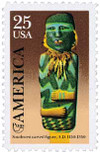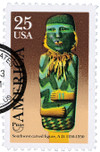
# 2426 - 1989 25c Southwest Carved Figure
U.S. #2426
1989 25¢ Southwest Carved Figure
America Series
- First stamp in the America Series, a collaboration between 24 Western Hemisphere countries
- Pictures a ceremonial wooden statuette from the Southwest
- The image of the statue is reversed because the artist worked from photo negatives
Stamp Category: Commemorative
Series: America
Value: 25¢, first-class rate
First Day of Issue: October 12, 1989
First Day City: San Juan Puerto Rico (ceremony canceled)
Quantity Issued: 137,410,000
Printed by: American Bank Note Company
Printing Method: Photogravure
Format: Panes of 50 in sheets of 200
Perforations: 11
Why the stamp was issued: As the inaugural stamp in the multi-national America series. The series would feature stamps with themes relating to America leading up to 1992, the 500th anniversary of the arrival of Christopher Columbus.
About the stamp design: The theme of the first year’s stamps was pre-Columbian artifacts. The USPS felt they were at a disadvantage, as other countries had more colorful and interesting subjects to choose from. USPS art director Richard Sheaf consulted with several museums to identify fitting artifacts for the stamp. Among those he initially sketched were a carved deer’s head, an Iroquois bone comb, and a mother and child figurine. While they were pleased with these, the USPS asked for one more sketch, depicting an item from the Southwest. The item he ended up drawing that was selected for the stamp was a ceremonial wooden statuette from the collection of the Art Institute of Chicago. Lon Busch was then hired to paint the statuette. They chose to have him paint it, rather than use photos for the stamp art, because they felt the colors could come out cleaner and simpler in paint.
Special design details: Lon Busch created his painting of the statuette from photos and color transparencies, rather than from life. Despite extensive communications to prevent it, he ended up painting the statuette flipped.
First Day City: The USPS had planned a first-day ceremony for this stamp to be held in San Juan, Puerto Rico, but the island had been devastated by Hurricane Hugo weeks before and the ceremony was canceled. However, stamps were still sold and covers canceled there on that day.
About the America Series: Issued between 1989 and 1992, the America Series was a collaboration between the 24 Western Hemisphere countries in the Postal Union of the Americas and Spain (PUAS). PUAS was originally founded in 1911 as the South American Postal Union to encourage the improvement of postal services. The US joined the union in 1922.
In 1985, the PUAS congress approved the America Series – a multi-year, multi-national series in which the participating nations would issue stamps with themes relating to America. The purpose of the series was to honor the 500th anniversary of Christopher Columbus’ discovery of the New World. The themes would be: 1989 – pre-Columbian people and their customs, 1990 – natural surroundings seen by discoverers, 1991 – the discovery voyages, and 1992 – the 500th anniversary of the arrival of Christopher Columbus.
In 1988, two USPS officials flew to Havana, Cuba, a country with no diplomatic relations with the US at the time, and whose stamps were embargoed, to discuss the project with other members of the PUAS. The meeting was intended to coordinate efforts between the nations on design and marketing and to help those countries that had research, design, or printing issues. Each stamp from each country had to include a special PUAS logo and a stylized posthorn and the word AMERICA larger than the issuing country’s name. In the Spanish-speaking countries, the logo is UPAE, for Union Postal de las Américas y España. Click here for the first 5 stamps in the series.
By 1992, USPS interest in the series had waned. While they did issue a set of four stamps honoring the arrival of Christopher Columbus, the stamps and selvage had no mention of PUAS and didn’t include the large AMERICA wording. The 1992 block was also a joint issue with Italy. Click here for that block (#2620-23).
History the stamp represents: People identified as being from the Mimbres culture lived in eastern Arizona and southwestern New Mexico about 1,000 years ago. Mimbres culture takes its name from the Mimbres River valley.
This painted wooden figure has been carbon dated to between AD 1150 and 1350. Carved in cottonwood and painted, its part of one of the most important groups of ancient North American art objects ever uncovered. It was part of an altar of 10 items found in a small cave in the Cliff Valley. Among the other items is a female figure. It’s believed these two figures represent the Sky (male) and Earth (female) deities. The male figure on this stamp is considered one of the most impressive human carvings from the ancient Pueblos. He’s shown wearing a necklace of feathers from 11 different bird species. The turquoise lightning bolts and black and white diamonds are believed to symbolize the stars.
Along with several other objects, this statuette was wrapped in a cloth dated AD 1400 to 1540, which indicated it was already quite old when it was hidden away. Scientists believe overpopulation, drought, and pressure from emerging tribes led the Mimbres people to abandon their settlements around AD 1130.
U.S. #2426
1989 25¢ Southwest Carved Figure
America Series
- First stamp in the America Series, a collaboration between 24 Western Hemisphere countries
- Pictures a ceremonial wooden statuette from the Southwest
- The image of the statue is reversed because the artist worked from photo negatives
Stamp Category: Commemorative
Series: America
Value: 25¢, first-class rate
First Day of Issue: October 12, 1989
First Day City: San Juan Puerto Rico (ceremony canceled)
Quantity Issued: 137,410,000
Printed by: American Bank Note Company
Printing Method: Photogravure
Format: Panes of 50 in sheets of 200
Perforations: 11
Why the stamp was issued: As the inaugural stamp in the multi-national America series. The series would feature stamps with themes relating to America leading up to 1992, the 500th anniversary of the arrival of Christopher Columbus.
About the stamp design: The theme of the first year’s stamps was pre-Columbian artifacts. The USPS felt they were at a disadvantage, as other countries had more colorful and interesting subjects to choose from. USPS art director Richard Sheaf consulted with several museums to identify fitting artifacts for the stamp. Among those he initially sketched were a carved deer’s head, an Iroquois bone comb, and a mother and child figurine. While they were pleased with these, the USPS asked for one more sketch, depicting an item from the Southwest. The item he ended up drawing that was selected for the stamp was a ceremonial wooden statuette from the collection of the Art Institute of Chicago. Lon Busch was then hired to paint the statuette. They chose to have him paint it, rather than use photos for the stamp art, because they felt the colors could come out cleaner and simpler in paint.
Special design details: Lon Busch created his painting of the statuette from photos and color transparencies, rather than from life. Despite extensive communications to prevent it, he ended up painting the statuette flipped.
First Day City: The USPS had planned a first-day ceremony for this stamp to be held in San Juan, Puerto Rico, but the island had been devastated by Hurricane Hugo weeks before and the ceremony was canceled. However, stamps were still sold and covers canceled there on that day.
About the America Series: Issued between 1989 and 1992, the America Series was a collaboration between the 24 Western Hemisphere countries in the Postal Union of the Americas and Spain (PUAS). PUAS was originally founded in 1911 as the South American Postal Union to encourage the improvement of postal services. The US joined the union in 1922.
In 1985, the PUAS congress approved the America Series – a multi-year, multi-national series in which the participating nations would issue stamps with themes relating to America. The purpose of the series was to honor the 500th anniversary of Christopher Columbus’ discovery of the New World. The themes would be: 1989 – pre-Columbian people and their customs, 1990 – natural surroundings seen by discoverers, 1991 – the discovery voyages, and 1992 – the 500th anniversary of the arrival of Christopher Columbus.
In 1988, two USPS officials flew to Havana, Cuba, a country with no diplomatic relations with the US at the time, and whose stamps were embargoed, to discuss the project with other members of the PUAS. The meeting was intended to coordinate efforts between the nations on design and marketing and to help those countries that had research, design, or printing issues. Each stamp from each country had to include a special PUAS logo and a stylized posthorn and the word AMERICA larger than the issuing country’s name. In the Spanish-speaking countries, the logo is UPAE, for Union Postal de las Américas y España. Click here for the first 5 stamps in the series.
By 1992, USPS interest in the series had waned. While they did issue a set of four stamps honoring the arrival of Christopher Columbus, the stamps and selvage had no mention of PUAS and didn’t include the large AMERICA wording. The 1992 block was also a joint issue with Italy. Click here for that block (#2620-23).
History the stamp represents: People identified as being from the Mimbres culture lived in eastern Arizona and southwestern New Mexico about 1,000 years ago. Mimbres culture takes its name from the Mimbres River valley.
This painted wooden figure has been carbon dated to between AD 1150 and 1350. Carved in cottonwood and painted, its part of one of the most important groups of ancient North American art objects ever uncovered. It was part of an altar of 10 items found in a small cave in the Cliff Valley. Among the other items is a female figure. It’s believed these two figures represent the Sky (male) and Earth (female) deities. The male figure on this stamp is considered one of the most impressive human carvings from the ancient Pueblos. He’s shown wearing a necklace of feathers from 11 different bird species. The turquoise lightning bolts and black and white diamonds are believed to symbolize the stars.
Along with several other objects, this statuette was wrapped in a cloth dated AD 1400 to 1540, which indicated it was already quite old when it was hidden away. Scientists believe overpopulation, drought, and pressure from emerging tribes led the Mimbres people to abandon their settlements around AD 1130.












